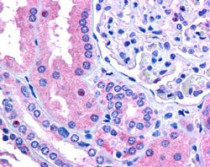ARG64109
anti-RNF213 / C17orf 27 antibody
anti-RNF213 / C17orf 27 antibody for IHC-Formalin-fixed paraffin-embedded sections and Human
Cell Biology and Cellular Response antibody
Overview
| Product Description | Goat Polyclonal antibody recognizes RNF213 / C17orf 27 |
|---|---|
| Tested Reactivity | Hu |
| Tested Application | IHC-P |
| Host | Goat |
| Clonality | Polyclonal |
| Isotype | IgG |
| Target Name | RNF213 / C17orf 27 |
| Antigen Species | Human |
| Immunogen | C-KTAAVLKWNRE |
| Conjugation | Un-conjugated |
| Alternate Names | MYMY2; EC 6.3.2.-; NET57; E3 ubiquitin-protein ligase RNF213; ALK lymphoma oligomerization partner on chromosome 17; KIAA1618; RING finger protein 213; Mysterin; ALO17; MYSTR; C17orf27 |
Application Instructions
| Application Suggestion |
|
||||
|---|---|---|---|---|---|
| Application Note | IHC-P: Antigen Retrieval: Steam tissue section in Citrate buffer (pH 6.0). * The dilutions indicate recommended starting dilutions and the optimal dilutions or concentrations should be determined by the scientist. |
Properties
| Form | Liquid |
|---|---|
| Purification | Purified from goat serum by antigen affinity chromatography. |
| Buffer | Tris saline (pH 7.3), 0.02% Sodium azide and 0.5% BSA. |
| Preservative | 0.02% Sodium azide |
| Stabilizer | 0.5% BSA |
| Concentration | 0.5 mg/ml |
| Storage Instruction | For continuous use, store undiluted antibody at 2-8°C for up to a week. For long-term storage, aliquot and store at -20°C or below. Storage in frost free freezers is not recommended. Avoid repeated freeze/thaw cycles. Suggest spin the vial prior to opening. The antibody solution should be gently mixed before use. |
| Note | For laboratory research only, not for drug, diagnostic or other use. |
Bioinformation
| Database Links |
Swiss-port # Q63HN8 Human E3 ubiquitin-protein ligase RNF213 |
|---|---|
| Background | This gene encodes a protein containing a C3HC4-type RING finger domain, which is a specialized type of Zn-finger that binds two atoms of zinc and is thought to be involved in mediating protein-protein interactions. The protein also contains an AAA domain, which is associated with ATPase activity. This gene is a susceptibility gene for Moyamoya disease, a vascular disorder of intracranial arteries. This gene is also a translocation partner in anaplastic large cell lymphoma and inflammatory myofibroblastic tumor cases, where a t(2;17)(p23;q25) translocation has been identified with the anaplastic lymphoma kinase (ALK) gene on chromosome 2, and a t(8;17)(q24;q25) translocation has been identified with the MYC gene on chromosome 8. Alternative splicing results in multiple transcript variants. [provided by RefSeq, Dec 2011] |
| Research Area | Cell Biology and Cellular Response antibody |
| Calculated MW | 591 kDa |
| PTM | Autoubiquitinated. |
Images (1) Click the Picture to Zoom In






